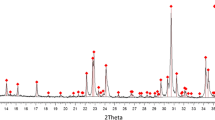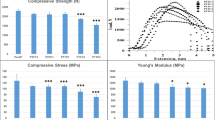Abstract
The biocompatibility of a reinforced calcium phosphate injectable bone substitute (CPC-IBS) containing 30% poly-ε-caprolactone (PCL) microspheres was evaluated. The IBS consisted of a solution of chitosan and citric acid as the liquid phase and tetracalcium phosphate (TTCP) and dicalcium phosphate anhydrous (DCPA) powder as the solid phase with 30% PCL microspheres. The surface of the CPC-IBS was observed by SEM, and analyzed by EDX profiles. The initial setting of the sample was lower in the IBS containing 0% citric acid than in the IBS containing 10 or 20% citric acid. The compressive strength of the PCL-incorporated CPC-IBS was measured using a Universal Testing Machine. The 20% citric acid samples had the highest mechanical strength at day 12, which was dependent on both time and the citric acid concentration. The in vitro bioactivity experiments with simulated body fluid (SBF) confirmed the formation of apatite on the sample surfaces after 2, 7, and 14 days of incubation in SBF. Ca and P ion release profile by ICP method also confirmed apatite nucleation on the CPC-IBS surfaces. The in vitro biocompatibility of the CPC-IBS was evaluated by using MTT, cellular adhesion, and spreading studies. In vitro cytotoxicity tests by MTT assay showed that the 0 and 10% CPC-IBS was cytocompatible for fibroblast L-929 cells. The SEM micrograph confirmed that MG-63 cells maintained their phenotype on all of the CPC-IBS surfaces although cellular attachment was better in 0 and 10% CPC-IBS than 20% samples.









Similar content being viewed by others
References
Dorozhkin SV. Calcium orthophosphate. J Mater Sci. 2007;42:1061–95.
Ripamonti U. Osteoinduction in porous hydroxyapatite implanted in heterotopic sites of different animal models. Biomaterials. 1996;17:31–5.
Yamasaki H, Saki H. Osteogenic response to porous hydroxyapatite ceramics under the skin of dogs. Biomaterials. 1992;13:308–12.
Toth M, Lynch KL, Hackbarth DA. Ceramic-induced osteogenesis following subcutaneous implantation of calcium phosphates. Bioceramics. 1993;6:9–13.
Yang Z, Yuan H, Tong W, Zou P, Chen W, Zhang X. Osteogenesis in extraskeletally implanted porous calcium phosphate ceramics: variability among different kinds of animals. Biomaterials. 1996;17:2131–7.
Hench LL. Biomaterials: a forecast for the future. Biomaterials. 1998;19:1419–23.
Oonishi H. Orthopaedic applications of hydroxyapatite. Biomaterials. 1991;12:171–8.
Yang S, Leong K-F, Du Z, Chua C-K. The design of scaffolds for use in tissue engineering. Part I. Traditional factors. Tissue Eng. 2001;7:679–89.
Brown WE, Chow LC. A new calcium phosphate water setting cement. In: Brown PW, editor. Cement research progress. Westerville: American Ceramic Society; 1986. p. 352–79.
Ginebra MP, Trycova T, Planell JA. Calcium phosphate cements as bone drug delivery systems: a review. J Control Release. 2006;113:102–10.
Chow LC. Calcium phosphate cements: chemistry, properties, and applications. Mater Res Soc Symp Proc. 2000;599:27–37.
Chow LC, Takagi S. A natural bone cement—a laboratory novelty led to the development of revolutionary New biomaterials. J Res Natl Stand Technol. 2001;106:1029–33.
Thai VV, Lee BT. Fabrication of calcium phosphate-calcium sulfate injectable bone substitute using hydroxyl-propyl-methyl-cellulose and citric acid. J Mater Sci Mater Med. 2010;21:1867–74.
Jyoti MA, Thai VV, Min YK, Lee BT, Song HY. In vitro bioactivity and biocompatibility of calcium phosphate cements using Hydroxy-propyl-methyl-Cellulose (HPMC). Appl Surf Sci. 2010;257:1533–9.
Machida Y, Nagai T, Abe M, Sannan T. Use of chitosan and hydroxypropylchitosan in drug formulations to effect sustained release. Drug Dis Deliv. 1986;1:119–30.
Muzzarelli RAA, Biagini G, Bellardini M, Simonelli L, Castaldini C, Fraatto G. Osteoconduction exerted by methylpyrolidinone chitosan in dental surgery. Biomaterials. 1993;14:39–43.
Suh JKF, Mathew HWT. Application of chitosan-based polysaccharide biomaterials in cartilage tissue engineering: a review. Biomaterials. 2000;21:2589–98.
Okuyama K, Noguchi K, Hanafusa Y, Osawa K, Ogawa K. Structural study of anhydrous tendon chitosan obtained via chitosan/acetic acid complex. Int J Biol Macromol. 1999;26:285–93.
Zhang Y, Zhang M. Synthesis and characterization of macroporous chitosan/calcium phosphate composite scaffolds for tissue engineering. J Biomed Mater Res. 1997;35:273–7.
Nijenhuis AJ, Colstee E, Grijpma DW, Pennings AJ. High molecular weight poly(l-lactide) and poly(ethylene oxide) blends: thermal characterization and physical properties. Polymer. 1996;37:5849–57.
Sinha VR, Bansal K, Kausik R, Kumrika R, Trehan A. Poly-ε-caprolactone microsphere and nanospheres: an overview. Int J Pharma. 2004;278:1–23.
Gross RA, Kalra B. Biodegradable polymers for the environment. Science. 2002;297:803–7.
Ishaug-Riley SL, Crane-Kruger GM, Yaszemski MJ, Mikos AG. Three-dimensional culture of rat calvarial osteoblasts in porous biodegradable polymers. Biomaterials. 1998;19:1405–12.
Peter SJ, Miller MJ, Yasko AW, Yaszemski MJ, Mikos AG. Polymer concepts in tissue engineering. J Biomed Mater Res A. 1998;43:422–7.
Porter JR, Henson A, Popat KC. Biodegradable poly (3-caprolactone) nanowires for bone tissue engineering applications. Biomaterials. 2009;30:780–8.
Iooss P, Ray A-ML, Grimandi G, Daculsi G, Merle C. A new injectable bone substitute combining poly (ε-caprolactone) microparticles with biphasic calcium phosphate granules. Biomaterials. 2001;22:2785–94.
Chang C-M, Bodmeier R. Organic solvent-free polymeric microspheres prepared from aqueous colloidal polymer dispersions by a w/o-emulsion technique. Int J Pharm. 1996;130:187–94.
Sargin Y, Kizilyalli M, Telli C, Güler H. A new method for the solid-state synthesis of tetracalcium phosphate, a dental cement: X-ray diffraction and IR studies. J Eur Ceram Soc. 1997;17:963–70.
Guo D, Xu K, Han Y. Influence of cooling modes on purity of solid-state synthesized tetracalcium phosphate. Mater Sci Eng B. 2005;116:175–81.
ISO 9917-1. Dentistry-water-based cements-part 1: powder/liquid acid based cements. Geneva: ISO; 2003.
Kokubo T. Bioactive glass ceramics: properties and applications. Biomaterials. 1991;12:155–63.
Kokubo T, Takadama H. How useful SBF in predicting in vivo bone bioactivity? Biomaterials. 2006;27:2907–15.
Mickisch G, Fajta S, Keilhauer G, Schlick E, Tschada R, Alken P. Chemosensitivity testing of primary human renal cell carcinoma by a tetrazolium based microculture assay (MTT). Urol Res. 1990;18:131–6.
International standard. Biological evaluation of medical devices. Part 5: Test for in vitro cytotoxicity. ISO-10993-5:1999 (E); 1999.
Hott M, Noel B, Bernache-Assolant D, Rey C, Marie PJ. Proliferation and differentiation of human trabecular osteoblastic cells on hydroxyapatite. J Biomed Mater Res. 1997;37:508–16.
Pioletti DP, Muller J, Rakotomanana LR. Effect of micromechanical stimulations on osteoblasts: development of a device simulating the mechanical situation at the bone implant interface. Biomechanics. 2003;36:131–5.
Nanci A, Wuest JD, Peru L, Brunet P, Sharma V, Zalzal S, McKee MD. Chemical modification of titanium surfaces for covalent attachment of biological molecules. J Biomed Mater Res. 1998;40:324–35.
Webb K, Hlady V, Tresco PA. Relationships among cell attachment, spreading, cytoskeletal organization, and migration rate for anchorage-dependent cells on model surfaces. J Biomed Mat Res. 2000;49:362–8.
Bigerelle M, Anselme K, Dufresne E. An unscaled parameter to measure the order of surfaces: a new surface elaboration to increase cells adhesion. Biomol Eng. 2002;19:79–83.
Kasten P, Beyen I, Niemeyer P, Luginbühl R, Bohner M, Richter W. Porosity and pore size of [beta]-tricalcium phosphate scaffold can influence protein production and osteogenic differentiation of human mesenchymal stem cells: an in vitro and in vivo study. Acta Biomater. 2008;4:1904–15.
Yamauchi K, Takahashi T, Funaki K, Hamada Y, Yamashita Y. Histological and histomorphometrical comparative study of β-tricalcium phosphate block grafts and periosteal expansion osteogenesis for alveolar bone augmentation. Int J Oral Maxillofac Surg. 2010;39:1000–6.
Weiss P, Layrolle P, Clergeau LP, Enckel B, Pilet P, Amouriq Y, Daculsi G, Giumelli B. The safety and efficacy of an injectable bone substitute in dental sockets demonstrated in a human clinical trial. Biomaterials. 2007;28:3295–305.
Chen W-C, Ju C-P, Tien Y-C, Lin J-HC. In vivo testing of nanoparticle-treated TTCP/DCPA-based ceramic surfaces. Acta Biomater. 2009;5:1767–74.
Sarda S, Fernández E, Nilsson M, Balcells M, Planell JA. Kinetic study of citric acid influence on calcium phosphate bone cements as water-reducing agent. J Biomed Mater Res. 2002;61:653–9.
Kim Y-H, Jyoti MA, Youn M-H, Youn H-S, Seo H-S, Lee B-T, Song H-Y. In vitro and in vivo evaluation of a macro porous β-TCP granule shaped bone substitute fabricated by the fibrous monolithic process. Biomed Mater. 2010;5:1–11.
Ciapetti G, Cenni E, Pratelli L, Pizzoferrato A. In vitro evaluation of cell/biomaterial interaction by MTT assay. Biomaterials. 1993;14:359–64.
Tettamanti G, Grimaldi A, Rinaldi L, Arnaboldi F, Congiu T, Valvassori R, de Eguileor M. The multifunctional role of fibroblasts during wound healing in Hirudo medicinalis (Annelida, Hirudinea). Biol Cell. 2004;96:443–55.
Mossman BT. In vitro studies on the biologic effects of fibers: correlation with in vivo bioassays. Environ Health Perspect. 1990;88:319–22.
Mossman BT. In vitro approaches for determining mechanisms of toxicity and carcinogenicity by asbestos in the gastrointestinal and respiratory tracts. Environ Health Perspect. 1983;53:155–61.
Author information
Authors and Affiliations
Corresponding author
Rights and permissions
About this article
Cite this article
Jyoti, M.A., Song, HY. Initial in vitro biocompatibility of a bone cement composite containing a poly-ε-caprolactone microspheres. J Mater Sci: Mater Med 22, 1333–1342 (2011). https://doi.org/10.1007/s10856-011-4311-x
Received:
Accepted:
Published:
Issue Date:
DOI: https://doi.org/10.1007/s10856-011-4311-x




